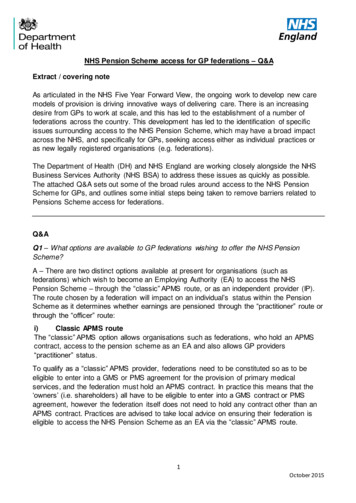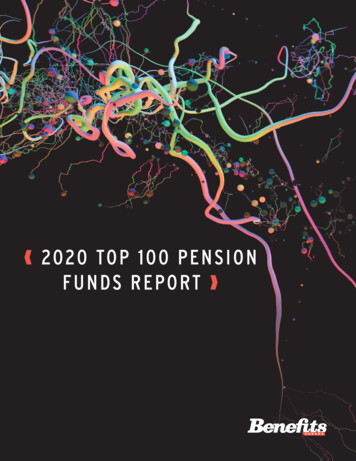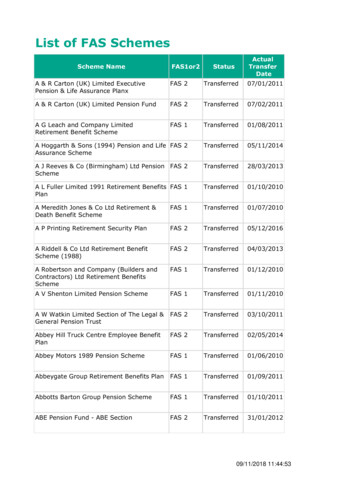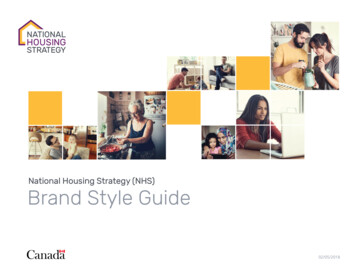
Transcription
NHS Pension Scheme access for GP federations – Q&AExtract / covering noteAs articulated in the NHS Five Year Forward View, the ongoing work to develop new caremodels of provision is driving innovative ways of delivering care. There is an increasingdesire from GPs to work at scale, and this has led to the establishment of a number offederations across the country. This development has led to the identification of specificissues surrounding access to the NHS Pension Scheme, which may have a broad impactacross the NHS, and specifically for GPs, seeking access either as individual practices oras new legally registered organisations (e.g. federations).The Department of Health (DH) and NHS England are working closely alongside the NHSBusiness Services Authority (NHS BSA) to address these issues as quickly as possible.The attached Q&A sets out some of the broad rules around access to the NHS PensionScheme for GPs, and outlines some initial steps being taken to remove barriers related toPensions Scheme access for federations.Q&AQ1 – What options are available to GP federations wishing to offer the NHS PensionScheme?A – There are two distinct options available at present for organisations (such asfederations) which wish to become an Employing Authority (EA) to access the NHSPension Scheme – through the “classic” APMS route, or as an independent provider (IP).The route chosen by a federation will impact on an individual’s status within the PensionScheme as it determines whether earnings are pensioned through the “practitioner” route orthrough the “officer” route:i)Classic APMS routeThe “classic” APMS option allows organisations such as federations, who hold an APMScontract, access to the pension scheme as an EA and also allows GP providers“practitioner” status.To qualify as a “classic” APMS provider, federations need to be constituted so as to beeligible to enter into a GMS or PMS agreement for the provision of primary medicalservices, and the federation must hold an APMS contract. In practice this means that the‘owners’ (i.e. shareholders) all have to be eligible to enter into a GMS contract or PMSagreement, however the federation itself does not need to hold any contract other than anAPMS contract. Practices are advised to take local advice on ensuring their federation iseligible to access the NHS Pension Scheme as an EA via the “classic” APMS route.1October 2015
A hybrid NHS Standard / APMS Contract was published by NHS England in March 2015,where commissioners wished to commission both primary and community / secondaryservices through the same contract. This hybrid contract is starting to be used byfederations however it has raised concerns about the way this contract is treated forpensions purposes.Through work between the DH and NHS England, the status of the hybrid contract for hasnow been clarified, allowing it to be recognised by the NHS Business Services Authority(NHS BSA) as an APMS Contract as well as a NHS Standard Contract, ensuring earningsfrom this contract can be pensioned under “practitioner” status. This move is possiblebecause the hybrid contract meets the requirements set out in the APMS Directions, andrecognising it formally as an APMS contract therefore removes a barrier for federationswishing to use the “classic” APMS route to access the NHS Pension Scheme. This formalrecognition as an APMS contract will be retrospectively applied, so all signed hybridcontracts can be recognised as APMS contracts for pensions purposes.Please note that whilst this change clarifies the use of the hybrid contract for pensionspurposes, it does not remove the requirement that the hybrid contract must only be usedwhere both primary and community / secondary services are being commissioned underthe same contract. The hybrid contract should not be used to commission solely primarycare services.ii)Independent Provider routeThe IP route is for organisations using NHS contracts that do not already qualify to be anexisting NHS Pension Scheme EA. For GPs, this would apply where they were employedby a non-NHS contracting organisation, or a GP led organisation such as a federationwhich was not constituted so as to allow access via the “classic” APMS route. This routehas been available since 1 April 2014. Employees of an IP are eligible for membership ofthe NHS Pension Scheme provided they spend more than 50% of their time [across apension scheme year – 1st April to 31st March] working on the services provided under theNHS Standard Contract, an APMS contract, a hybrid NHS Standard Contract / APMScontract, or a local authority contract. Employees in providers who choose to access thepension through this route are only eligible for “officer” status, and not for “practitioner”status.Q2 – What if a GP (GMS, or PMS) surgery is already an NHS Pension Scheme employingauthority (EA) which wins additional work via an NHS Standard Contract?A – Since an amendment to the NHS Pension Scheme regulations in April 2014, thesurgery’s GPs (practitioners) and employees must pension the income from the NHSStandard Contract in addition to their GMS, PMS or APMS income. There would be noneed for such an organisation to apply to become an IP.Q3 – Will it become possible to pension income/earnings received via sub-contracting?2October 2015
A – At present there are no circumstances where payments through an intermediary or subcontracting route are currently pensionable. This is a deliberate control designed to limitinappropriate extension of scheme liabilities.The sub-contracting question could begin to affect a significant number of organisations asthe new care model vanguards move towards developing an accountable lead providerorganisation. Given the likelihood of organisations, including possibly GP federations,becoming sub-contractors, the DH and NHS England have been working to find a solutionto this problem.A first step is that the DH has agreed to consider a change to the NHS Pension Schemeregulations in April 2016 which will allow income from a sub-contract with another PensionScheme EA to be treated as pensionable earnings for practitioners. This will form part of aforthcoming public consultation planned by the DH in late 2015. Assuming this amendmentto the regulations is made GPs who begin to do sub-contracted work will be able to claimthe new income under their current terms, assuming the practice concurrently holds a GMS,PMS or APMS contracts. This proposed amendment is expected to be effective from 1 April2016.Q4 – Are there any alternatives to sub-contracting which practices could explore in themeantime?A –In the first instance, federations should consider whether it is appropriate or possible toset themselves up constitutionally to become an EA through the “classic” APMS route,holding a hybrid or APMS contract, and therefore provide services directly. Separately, afederation which has accessed EA status through the Independent Provider route couldemploy GPs, which would allow income from the federation to be pensioned as an “officer”.Where a federation employee is also in pensionable employment elsewhere, that individualcould have two concurrent pensionable posts (subject to not exceeding an aggregate ofwhole time). The 50% rule for IPs means that the GP must spend 50% of their time in theirIP role on activities relating to the qualifying NHS contract.Another potential option is for the clinical commissioning group (CCG) to considercontracting directly with each of the federation’s member surgeries, though this createsadditional complications for the administration of these contracts, so federations maychoose not to use this route given the other solutions in development and the broader aimof creating federations which provide services across a larger population. The CCG wouldthen pay the practices directly for the delivery of the services. The CCG could also enterinto a separate NHS standard contract with the federation who would manage and governthe delivery of the services on behalf of the CCG but would not be the route for any of thepayments.Q5 – What is the 75% pensionable pay threshold for IPs, and why is it not applicable toother EAs in the Scheme?A – The 75% pensionable pay threshold was introduced to ensure that when servicestransfer from a “traditional” NHS provider to an IP the pensionable pay, attracting a 14.3%3October 2015
employer contribution, remains broadly the same. This figure was chosen because, in theaverage NHS Trust setting, around 66% of total NHS funding remains available to spend asnet pensionable pay for staff once the organisation’s expenses for premises, medicalmaterials, national insurance and employer contributions to the NHS Pension Scheme arededucted. The 75% pay threshold should be relatively generous, given, in particular, thatnot all of an IPs staff may be engaged in the delivery of NHS clinical services for more than50% of their time. Both DH and NHS England will however continue to review this situationas further organisations become Employing Authorities under the IP route as the new caremodel vanguard sites develop.Q6 – Why can’t IP status be granted retrospectively and what options are available wherethere is a “gap” in pensionable service as a result?A – This was another control mechanism agreed during the policy development andregulatory refinement. DH is considering whether it remains a necessary and appropriatecontrol given the developing nature of service provision and an amendment to theregulations may be proposed in the forthcoming public consultation in late 2015.Where a federation is granted IP status, but there is a gap in their employees’ membershipof the NHS Pension Scheme, an option could be for the federation to use employee and/oremployer contributions (or monies that would have been treated as contributions) during thegap to buy an amount of ‘additional pension’ for affected individuals once admitted to thescheme. This would be credited to individuals as an extra amount of pension and servesthe purpose of restoring ‘lost’ pension.Q7 – Why is Practitioner status not afforded under the IP route?A – Practitioner status operates solely in relation to primary care. It is available only to GPsand dentists who are delivering primary care services under a GMS, PMS or APMScontract (or dental equivalents). It follows that salaried GPs, or GP providers, employed byan IP pension income from that employment as officers rather than practitioners.More generally, the introduction of the new NHS Pension Scheme in 2015 saw the removalof the distinction between officer and practitioner membership. The old scheme used theterms to differentiate between the two methods upon which benefits are built up bymembers; final salary for officers, career average earnings for practitioners. In the newscheme all members accrue benefits on a career average earnings basis. So for salariedGPs, or GP providers, who are members of the new NHS Pension Scheme 2015 there isno practitioner status to maintain.Q8 – Where can I find out more?A – The NHS Pension Scheme administrator – the NHS Business Services Authority – hasa section of its website dedicated to IPs which can be accessed via this linkhttp://www.nhsbsa.nhs.uk/4328.aspx4October 2015
Q9 – Who should I contact if I have further questions?A – You can email NHS BSA nhsbsa.directions@nhs.net, the Department of Health policyteam on nhs pp&e services@dh.gsi.gov.uk5October 2015
contract (or dental equivalents). It follows that salaried GPs, or GP providers, employed by an IP pension income from that employment as officers rather than practitioners. More generally, the introduction of the new NHS Pension Scheme in 2015 saw the removal of the distinction between officer and practitioner membership. The old scheme used the










